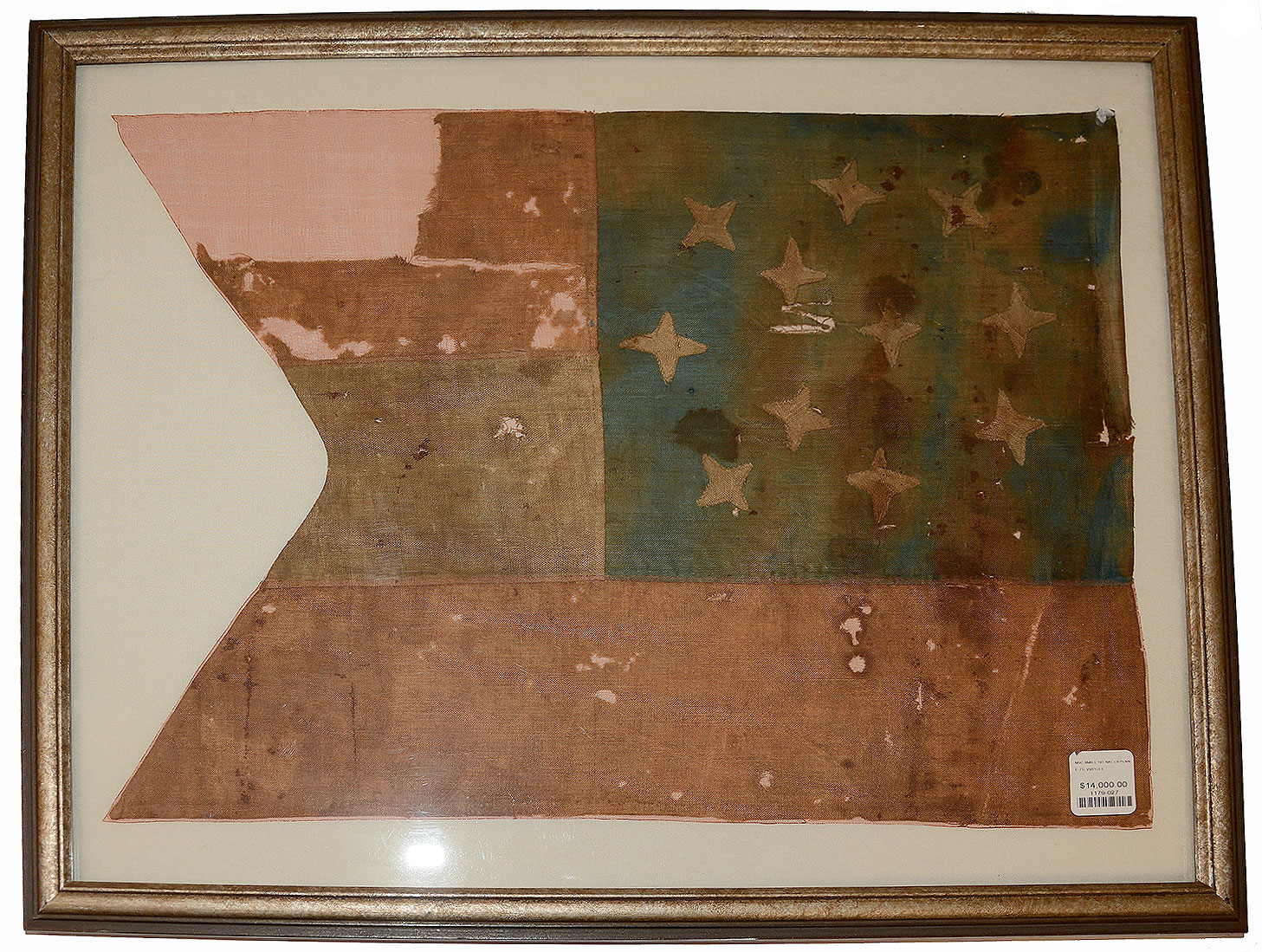site search
online catalog
RARE CONFEDERATE CAVALRY GUIDON

$10,500.00
Quantity Available: 1
Item Code: 1179-027A
Shipping: Determined by Method & Location of buyer
To Order:
Call 717-334-0347,
Fax 717-334-5016, or E-mail
This Confederate guidon comes from the collections of the Texas Civil War Museum. The flag has been professionally conserved, matted, and framed by Textile Preservation Associates and comes with their 1995 letters of examination, treatment, and analysis, drawings and slide photos, directions for handline and display, etc.
The flag measures 11 ½” on the leading edge and 16” on the fly, made of red, white and blue cotton in the form of a Confederate first national flag with a swallow tail and eleven stars in the canton arranged as a circle of 8 with 3 in the middle. The stars are 1 1/8” and four-pointed, not consistently shaped and crudely attached with unturned edges on the left, reverse, side only- that is: visible with the leading edge to the right and swallow tail to the left.
For exact measurements of the stripes, canton, details of construction, etc., we can supply copies of the TPA letters to interested purchasers. “The flag is intact as constructed with no alterations or repairs,” to quote their report. For condition, please refer to our photos and their report. The flag shows soiling and stains, with scattered small holes from use or damage, with muted, but clear colors. The only substantial damage is to the upper half of the top stripe, 5 ½” of which is missing from the tip toward the canton, with a tear 2 ½” from the top edge extending toward, but not all the way to, the canton. This has been backed with an appropriate matching color, as has the lower stripe. The neatness of the lower edge of the missing piece and that it took the point but not the whole width of the stripe suggests it may have been taken as a souvenir. Given its rarity and compared to some other extant examples, the condition is quite good and the flag is especially rare with its original lance.
Confederate guidons of this pattern are generally given a Virginia and specifically Richmond connection, with students of flags speculating they are the 283 lances and flags billed to the Confederate government by Burger and Brothers of Richmond in January 1862, with the flags themselves supplied to that company by a consortium of Richmond ladies (See Shannon Pritchard and Greg Biggs) and the lances and blades made by Burger. There may have been more than one delivery and a number seem to have remained unissued. Albaugh cites an 1881 newspaper inquiry by a Philadelphian who owned two large crates of these addressed to “Capt. Getty, C.S.A., Lynchburgh, Va.” who commanded the CS Ordnance Depot there 1862-1865. (We show a somewhat blurred digital copy of that advertisement.) He also records an 1896 receipt from the Richmond relic shop of Slater and Chandler: “Confederate Lance. Made in the South during the late Civil War. These weapons were among the munitions of war taken at the fall of Richmond in 1865. The pennons, the wrist loops, and the lance boot were of poor materials, and in most cases were lost or destroyed by accidents of service.” (Bannerman also got into the act, offering one for sale in his catalog, though without background or explanation.)
These were not merely unissued military surplus. Two examples of the pattern indicate issue and actual use in the field. One is in the collections of Pamplin Park, with a great brown label documenting its capture at Sailor’s Creek, April 6, 1865. The other was sold at auction in 2001, from an Ohio estate, carrying a convincing brown ink tag referring to it as a “cavalry flag,” and stating that it was captured at Shiloh, which points to some rather early war field use and that not all remained stored at Richmond or Lynchburg until capture or issue at the end of the war.
Scholars and students of flags seem to offer no explanation for the application of the stars to only one side of the canton. We hazard the possibility that one side was intentionally left for the application of a unit identification, though no such examples seem to have survived. In any case, this would further point to their intended use as guidons and not only lance pennants. The three red and white stripes alone on that side would have been sufficient to distinguish it at a distance from the prewar US pattern with just two broad stripes or the 1862 pattern using thirteen stripes like the full-scale regimental standards. The eleven stars of the seceded states on the other side, along with perhaps some gunfire and rebel-yells, would have confirmed the situation for any uncertain Union cavalry who got too close.
This would be a very strong addition to a flag collection and especially so to a Confederate cavalry collection. [sr][ph:L]
~~~~~~~~~~~~~~~~~~~~~~~~~~~~~~~~~~~
THIS ITEM, AS WITH ALL OTHER ITEMS AVAILABLE ON OUR WEB SITE,
MAY BE PURCHASED THROUGH OUR LAYAWAY PROGRAM.
CLICK HERE FOR OUR POLICIES AND TERMS.
THANK YOU!
Inquire About RARE CONFEDERATE CAVALRY GUIDON
For inquiries, please email us at [email protected]
Most Popular
Historical Firearms Stolen From The National Civil War Museum In Harrisburg, Pa »
Theft From Gravesite Of Gen. John Reynolds »
Selection Of Unframed Prints By Don Troiani »
Fine Condition Brass Infantry Bugle Insignia »
British Imported, Confederate Used Bayonet »
Scarce New Model 1865 Sharps Still In Percussion Near Factory New »
featured item
RARE EBERLE 1796 CONTRACT MARKED BAYONET
This rare bayonet is marked by the maker in a sunken cartouche with raised letters on the base of the blade reading “Eberle.” Charles Louis Eberle emigrated to the U.S. from Germany with brothers George A. and Henry J. in 1794, arriving in… (1052-86). Learn More »
site search
Upcoming Events
May 16 - 18: N-SSA Spring Nationals, Fort Shenandoah, Winchester, VA Learn More »





